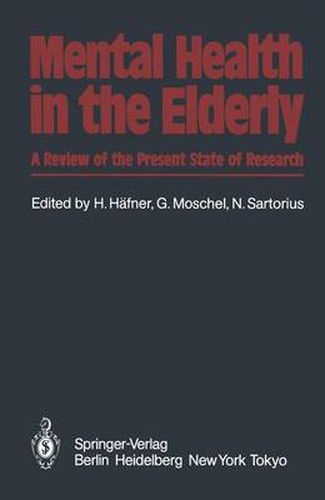Readings Newsletter
Become a Readings Member to make your shopping experience even easier.
Sign in or sign up for free!
You’re not far away from qualifying for FREE standard shipping within Australia
You’ve qualified for FREE standard shipping within Australia
The cart is loading…






This title is printed to order. This book may have been self-published. If so, we cannot guarantee the quality of the content. In the main most books will have gone through the editing process however some may not. We therefore suggest that you be aware of this before ordering this book. If in doubt check either the author or publisher’s details as we are unable to accept any returns unless they are faulty. Please contact us if you have any questions.
H. Hafner, G. Moschel, N. Sartorius The size of the world’s population aged over 65 was estimated at about 250 million in 1980; by the year 2025 it is expected to grow to about 760 million (see Hauser, this volume). This sharp increase in life expectancy at birth, in some countries amounting to almost 100% in only a hundred years, has resulted from better nutrition and improved living conditions, hygiene and medical care. Not only life expectancy at birth, but also further life expectancy in advanced age has shown a clear, though more moderate increase. This increased life expectancy, together with a simultaneous fall in birth rates, has caused the mean age of the world population and, especially, the average age of the population of industrial nations to climb substantially in recent times, a development which will reach its peak only some decades from now. For these demographic reasons alone, health care authorities will have to devote more attention to the health problems of the elderly. The main task of medical research is to develop improved methods of disease prevention and treatment. Yet, because the full benefits of such research are only realized after many years of work, researchers have already begun to respond to demographic pressures by focussing part of their efforts on the study of illnesses characteristic of old age.
$9.00 standard shipping within Australia
FREE standard shipping within Australia for orders over $100.00
Express & International shipping calculated at checkout
This title is printed to order. This book may have been self-published. If so, we cannot guarantee the quality of the content. In the main most books will have gone through the editing process however some may not. We therefore suggest that you be aware of this before ordering this book. If in doubt check either the author or publisher’s details as we are unable to accept any returns unless they are faulty. Please contact us if you have any questions.
H. Hafner, G. Moschel, N. Sartorius The size of the world’s population aged over 65 was estimated at about 250 million in 1980; by the year 2025 it is expected to grow to about 760 million (see Hauser, this volume). This sharp increase in life expectancy at birth, in some countries amounting to almost 100% in only a hundred years, has resulted from better nutrition and improved living conditions, hygiene and medical care. Not only life expectancy at birth, but also further life expectancy in advanced age has shown a clear, though more moderate increase. This increased life expectancy, together with a simultaneous fall in birth rates, has caused the mean age of the world population and, especially, the average age of the population of industrial nations to climb substantially in recent times, a development which will reach its peak only some decades from now. For these demographic reasons alone, health care authorities will have to devote more attention to the health problems of the elderly. The main task of medical research is to develop improved methods of disease prevention and treatment. Yet, because the full benefits of such research are only realized after many years of work, researchers have already begun to respond to demographic pressures by focussing part of their efforts on the study of illnesses characteristic of old age.